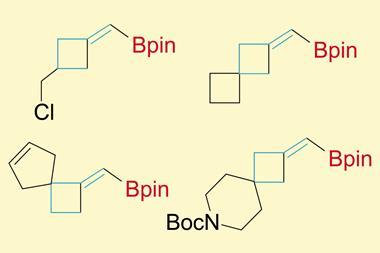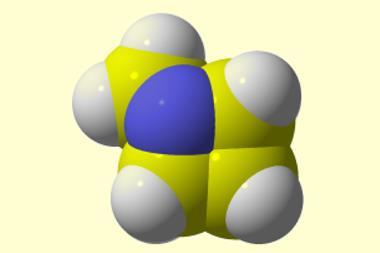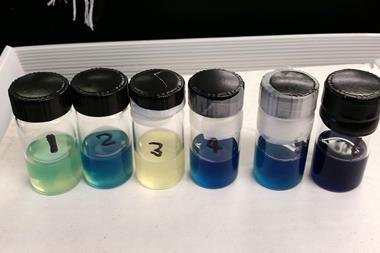Leaping to a greener approach for cubane synthesis
Cubane (CH)8 is an organic molecule of intrigue. The journey of cubane synthesis is nothing short of elegance that encompasses the accidental preparation of octaphenylcubane by H H Freedman and D R Peterson, followed by Philip Eaton and Thomas Cole’s seminal synthesis.
Cubane is a highly strained hydrocarbon with a perfect cubic symmetry, rendering it thermodynamically unstable. Due to high strain energy, cubane displays a large energy barrier for its ring opening and remarkable kinetic stability beyond 200°C. Cubane is a charming contender to benzene as both share close geometries, and are called bioisosteres. If functionalised at a few or all the carbon atoms, they have the prowess to exert pharmacokinetic properties and even replace phenyl (benzene) rings in potential drug candidates. Today, we are obtaining cubyl complexes and even rearranging cubanes to cuneanes and more recently, 1-azahomocubane.
In the 60 years that have elapsed since its first reported synthesis, cubane yields have been scaled to the decagram level.1 However, there is one crucial synthesis step that has challenged chemists when scaling up the process to industrial volumes. Dimethyl 1,4-cubanedicarboxylate is an expensive building block for cubane derivatives. Synthesising it requires a crucial intramolecular [2+2] π cycloaddition of dibromo-dione to cage dione. Until now, this reaction was promoted by mercury vapour lamps or expensive UV-B lamps under acidic conditions. Now, researchers from the University of St Andrews and AstraZeneca, UK, have demonstrated a decent leap towards optimising this step, using the cheap and widely available benzophenone as a photosensitizer.2
The team began its exploration by optimising conditions to allow low-energy LED light to mediate the cycloaddition reaction, avoiding the need for UV lamps. They hypothesised that cycloaddition could be driven by direct photoexcitation using either a Lewis acid catalyst or a photosensitizer.
Using a BCl3 catalyst to directly photoexcite dibromo-dione at 370nm produced no observable conversion (figure 1). With no reactivity, the team boosted the cycloaddition via Dexter energy transfer (DET) mechanism, in which visible light drove a triplet energy transfer from a photosensitizer to dibromo-dione. Photosensitizers are organic molecules that absorb light and transfer their excitation energies to another molecule. For a successful photosensitization, the triplet energies of the photosensitizer must be higher than that of dibromo-dione. The team used DFT calculations to estimate the triplet energy of dibromo-dione, using cyclohexenone as a test molecule due to their structural similarities. These calculations estimated the triplet energy of dibromo-dione at 67.3 kcal mol−1, thus cyclohexenone at 62.5 kcal mol−1 could not be used in the DET process. Comparing DFT estimates and triplet energies from the literature, benzophenone came to the rescue. Its triplet energy of 69.0 kcal mol−1, slightly higher than the triplet energy of dibromo-dione, makes it an ideal, cost-effective photosensitizer.
Irradiating a solution of dibromo-dione and benzophenone in acetonitrile at 390nm for 24 hours yielded cage dione. At this juncture, the team confirmed the catalyst loading and the necessity of benzophenone for this conversion. In the photoreactor, conversion did not occur in the absence of benzophenone. With intense irradiation at 390nm outside of a photoreactor, the conversion was feasible without benzophenone; however, benzophenone was essential to obtain usable quantities of cage dione. A 1 mmol scale gave 93% conversion to cage dione, confirmed by 1H-NMR studies.
In earlier work, cycloaddition was carried out using sulphuric acid/methanol that resulted in methyl ketal formation. Methyl ketals had to be hydrolysed by refluxing the reaction mixture in water before proceeding with rearranging the cage dione. As this new synthesis replaces these harsh conditions with benzophenone/acetonitrile, methyl ketals are not formed and hence the energy-intensive water hydrolysis step is obliterated. Cubane-1,4-dicarboxylic acid could be directly generated from the cage dione via Favorskii rearrangement.
The final stage of the synthesis esterified cubane-1,4-dicarboxylic acid to dimethyl 1,4-cubane dicarboxylate, which on hydrolysis gave 4-methoxycarbonylcubanecarboxylicacid (MCCCA). Attempts to decarboxylate MCCCA with an iridium-based photocatalyst yielded traces of methyl cubane-1-carboxylate (figure 2). Due to difficulties in precipitating dimethyl 1,4-cubanedicarboxylate, practical yields of the final product were not reported.
Despite low product yields, this work merits excitement for suggesting greener synthesis of functionalised cubanes. There is a large desire from industry to scale up greener reactions with minimal steps at lower energies and without compromised yields. Reaction conditions and product properties are decisive by nature. Hence, it is important to determine at an early stage of reaction development the required reactant-photosensitizer loadings, choice of visible-light photocatalysts and strategies on separation and purification of cubane derivatives. Once accomplished, chemists are at the crux of obtaining functionalised cubanes in a greener way.
References
1. D E Collin et al, Synthesis, 2021, 53, 1307 (DOI: 10.1055/s-0040-1705964)
2. C Prentice et al, Org. Biomol. Chem, 2023, 21, 3307 (DOI: 10.1039/D3OB00231D)














No comments yet